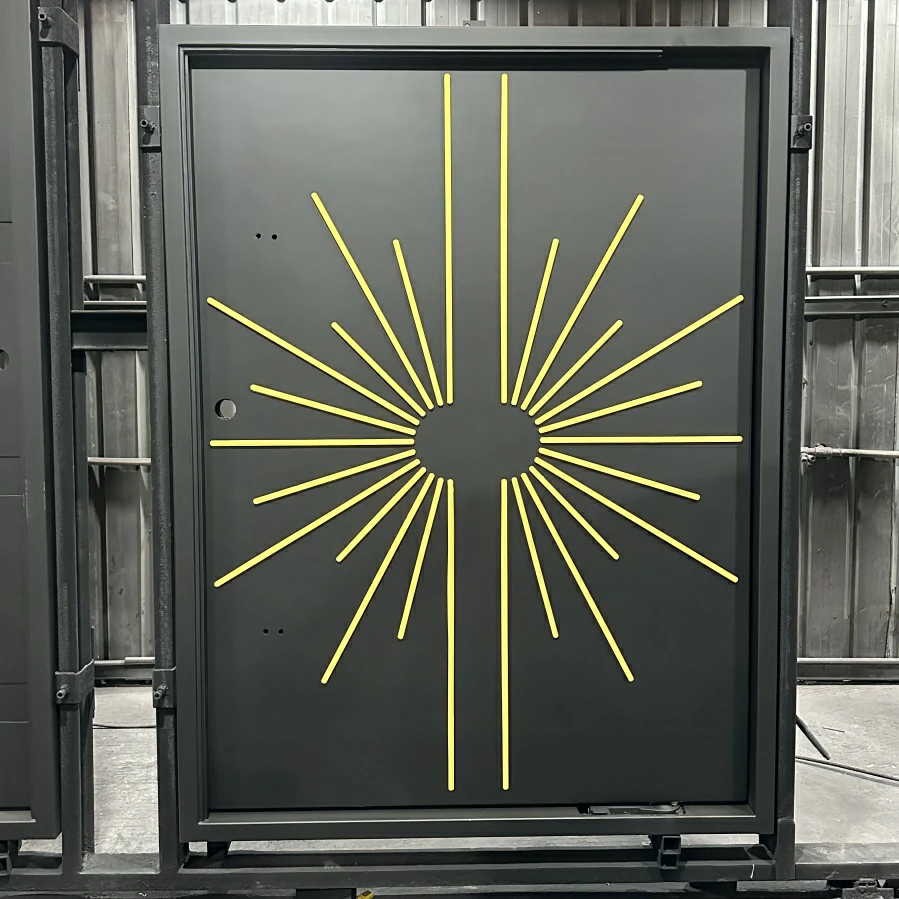The installation process of a metal pivot door differs from that of a traditional hinged door in several ways. Here are the key differences:
Pivot Hardware: Metal pivot doors utilize specialized pivot hardware that allows the door to rotate on a vertical axis, typically located at the top and bottom of the door frame. This hardware supports the weight of the door and enables it to swing smoothly. Traditional hinged doors, on the other hand, use hinges attached to the side of the door frame.
Structural Support: Metal pivot doors require proper structural support to accommodate the weight and movement of the door. Unlike traditional hinged doors, which rely on the door frame and surrounding wall for support, pivot doors often require additional structural elements, such as reinforced flooring or a load-bearing header, to ensure stability and prevent sagging.
Framing: The door frame for a metal pivot door is typically designed differently from that of a hinged door. It needs to accommodate the pivot hardware and allow for the door’s rotation without obstruction. The frame may be larger and sturdier to provide proper support and maintain the desired aesthetic.
Floor Clearance: Metal pivot doors often have a larger clearance between the bottom of the door and the floor compared to hinged doors. This clearance is necessary to accommodate the pivot hardware and allow the door to swing smoothly without scraping against the floor.
Installation Process: The installation of a metal pivot door usually requires more precision and expertise compared to a traditional hinged door. It may involve aligning and securely attaching the pivot hardware to the frame and floor, ensuring proper leveling and alignment of the door, and making any necessary adjustments for smooth operation.
Door Swing: Metal pivot doors can swing in both directions, depending on the design and hardware configuration. This flexibility allows for unique design possibilities and can be advantageous in spaces where traditional hinged doors may not be practical or desirable.
Architectural Considerations: Due to their larger size and unique mechanism, metal pivot doors may require careful consideration of architectural factors. This includes ensuring adequate space around the door for clearance, understanding the impact on adjacent walls or furniture, and addressing any potential structural implications.
It’s important to note that the specific installation process of a metal pivot door may vary depending on the manufacturer, design, and project requirements. metal pivot door It is recommended to consult the manufacturer’s installation guidelines or seek professional assistance to ensure a proper and successful installation.
How do metal pivot doors contribute to the overall aesthetic of a space, especially in modern or contemporary designs?
Metal pivot doors can make a significant contribution to the overall aesthetic of a space, particularly in modern or contemporary designs.
Here are some ways in which metal pivot doors enhance the visual appeal of a space:
Sleek and Minimalistic Look: Metal pivot doors often feature clean lines, smooth surfaces, and minimalistic designs. These characteristics align well with modern and contemporary design aesthetics that prioritize simplicity, elegance, and a streamlined appearance. The sleekness of metal surfaces can create a sense of sophistication and modernity.
Visual Contrast and Texture: Metal pivot doors can offer a striking contrast to surrounding materials such as wood, concrete, or glass. The juxtaposition of metal against other textures can create visual interest and add depth to the overall design. The reflective properties of metals, such as stainless steel or aluminum, can also introduce a sense of lightness and luminosity to the space.
Industrial and Urban Vibes: Metal materials are often associated with industrial or urban-inspired designs. Using metal pivot doors can evoke an industrial aesthetic, reminiscent of loft apartments, warehouses, or urban architectural elements. This can add a touch of urban chic or contemporary edge to the space.
Statement Piece: Metal pivot doors can serve as a focal point or a statement piece in a room. Their larger size and distinct design draw attention and become a visually captivating element within the space. The unique pivot mechanism itself can be an intriguing detail that adds interest and becomes a conversation starter.
Versatility in Design: Metal pivot doors offer versatility in terms of design possibilities. They can be customized with various finishes, patterns, or perforations to suit specific design preferences. Metal can be textured, polished, brushed, or patterned, allowing for a wide range of aesthetic choices. This versatility enables architects and designers to create unique and personalized metal pivot door designs that harmonize with the overall style of the space.
Transparency and Visual Connection: Some metal pivot doors incorporate glass panels or large windows, allowing for transparency and visual connection between different areas of the space. This feature can promote an open and airy feel, enhance natural light flow, and create visual continuity throughout the interior.
Durable and Long-lasting: Metal pivot doors are known for their durability and longevity. Their robust construction and resistance to warping or swelling, as compared to wooden doors, make them suitable for high-traffic areas or spaces where durability is essential. The enduring nature of metal contributes to the overall aesthetic by maintaining its appearance and functionality over time.
When incorporated thoughtfully into modern or contemporary designs, metal pivot doors can enhance the overall aesthetic by adding a sense of sophistication, elegance, and visual interest. They provide a unique combination of functionality and design, making them an attractive choice for architectural and interior design projects.
